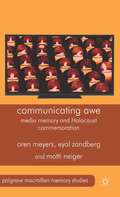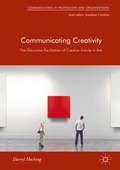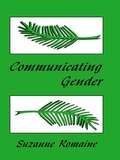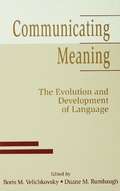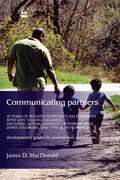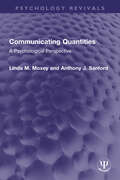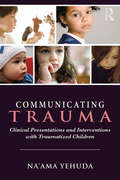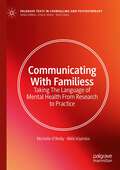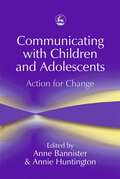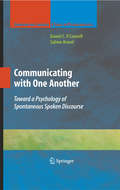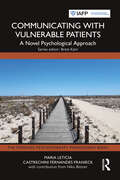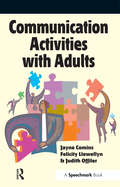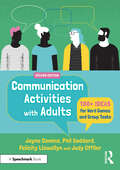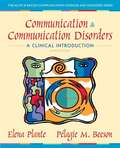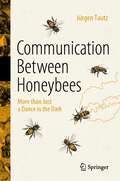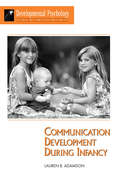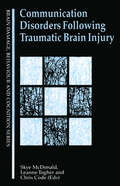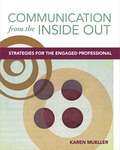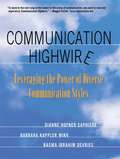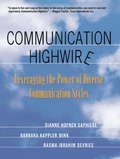- Table View
- List View
Communicating Awe: Media Memory And Holocaust Commemoration (Palgrave Macmillan Memory Studies)
by Motti Neiger Oren Meyers Eyal ZandbergOffering a cross-media exploration of Israeli media on Holocaust Remembrance Day, one of Israel's most sacred national rituals, over the past six decades, this fascinating book investigates the way in which variables such as medium, structure of ownership, genre and targeted audiences shape the collective recollection of traumatic memories.
Communicating Creativity: The Discursive Facilitation of Creative Activity in Arts (Communicating in Professions and Organizations)
by Darryl HockingThis book provides an extensive and original analysis of the way that written and spoken communication facilitates creative practice in the university art and design studio. Challenging the established view of creativity as a personal attribute which can be objectively measured, the author demonstrates instead that creativity and creative practice are constructed through a complex array of intersecting discourses, each shaped by wider socio-historical contexts, beliefs and values. The author draws upon a range of methods and resources to capture this dynamic complexity from corpus linguistics to ethnography and multimodal analysis. This innovative volume will appeal to students and scholars of discourse analysis, creativity, and applied linguistics. It will also appeal to art and design educators.
Communicating Gender
by Suzanne RomaineTaking a cross-disciplinary approach, Suzanne Romaine's main concern is to show how language and discourse play key roles in understanding and communicating gender and culture. In addition to linguistics--which provides the starting point and central focus of the book--she draws on the fields of anthropology, biology, communication, education, economics, history, literary criticism, philosophy, psychology, and sociology. The text covers the "core" areas in the study of language and gender, including how and where gender is indexed in language, how men and women speak, how children acquire gender differentiated language, and sexism in language and language reform. Although most of the examples are drawn primarily from English, other European languages and non-European languages, such as Japanese are considered. The text is written in an accessible way so that no prior knowledge of linguistics is necessary to understand the chapters containing linguistic analysis. Each chapter is followed by exercises and discussion questions to facilitate the book's use as a classroom text. The author reviews scholarly treatments of gender, and then uses her own data material from the corpora of spoken and written English usage. Special features include an examination of contemporary media sources such as newspapers, advertising, and television; a discussion of women's speculative fiction; a study of gender and advertising, with special attention paid to the role played by language in these domains; and a review of French feminist thought, particularly as it relates to the issue of language reform.
Communicating Meaning: The Evolution and Development of Language
by Duane M. Rumbaugh Boris M. VelichkovskyDealing specifically with the origins and development of human language, this book is based on a selection of materials from a recent international conference held at the Center of Interdisciplinary Research at the University of Bielefeld in Germany. The significance of the volume is that it testifies to paradigmatic changes currently in progress. The changes are from the typical emphasis on the syntactic properties of language and cognition to an analysis of biological and cultural factors which make these formal properties possible. The chapters provide in-depth coverage of such topics as new theoretical foundations for cognitive research, phylogenetic prerequisites and ontogenesis of language, and environmental and cultural forces of development. Some of the arguments and lines of research are relatively well-known; others deal with completely new interdisciplinary approaches. As a result, some of the authors' conclusions are in part, rather counterintuitive, such as the hypothesis that language as a system of formal symbolic transformations may be in fact a very late phenomenon located in the sphere of socio-cultural and not biological development. While highly debatable, this and other hypotheses of the book may well define research questions for the future.
Communicating Partners: 30 Years of Building Responsive Relationships with Late Talking Children including Autism, Asperger's Syndrome (ASD), Down Syndrome, and Typical Devel
by James D. MacdonaldCommunicating Partners, the result of over thirty years of clinical practice and research work with pre-verbal and verbal children with language delays, offers an innovative approach to working with late talking children that focuses on developing relationships through mutual understanding. Providing detailed maps of what children and their life partners need to do to ensure effective social relationships, the program focuses on five key stages of communication development - interactive play, nonverbal communication, social language, conversation, and civil behavior - and five life-long responsive strategies to use every day to build relationships within the child's own world. Communicating Partners addresses issues such as: * What does a child need to do before language? * What are effective ways to help a child socialize and communicate from early play through civil conversations? * How have parents successfully helped children learn to communicate at home? * How can a child develop socially effective language and conversation skills? * How can a child with an autistic spectrum disorder, Down Syndrome or other significant delays develop rich social relationships? * What have families done to build warm social relationships with their children? * What is developmentally effective therapy and education when social and communicative delays are of major concern? Illustrated with personal stories and research findings, and containing a wealth of practical suggestions to help parents, teachers, and professionals understand their child's world, Communicating Partners is an invaluable resource for all those interacting and working with late talking children.
Communicating Quantities: A Psychological Perspective (Psychology Revivals)
by Anthony J. Sanford Linda M. MoxeyEvery day, in many situations, we use expressions which seem to provide us with only vague information. The weather forecaster tells us that "some showers are likely in Northern regions during the night", a statement which is vague with respect to number of showers, location, and time. Yet such messages are informative, and often it is not possible for the producer of the message to be more precise. A tutor tells his students that "only a few students fail their exams outright". This does not give a precise incidence. Yet it might be equally misleading to do so. For example, to say that twelve percent failed outright last year says nothing about other years, while to say an average of eight percent over the last five years says nothing about variability. We argue that a precise, numerical statement can be sometimes more misleading in reality than a vague statement.Many researchers in psychology have attempted to capture the meaning of quantities by relating them to scales of quantity. Originally published in 1993, the book explores this idea in detail and shows with original studies how these expressions also serve to control attention and to convey information about the expectations held by those involved in the communication.The book works towards a psychological theory of the meaning of quantifiers and similarly vague terms. New links are drawn between formal theories of quantification and psychological experimentation.
Communicating Race, Ethnicity, and Identity in Technical Communication (Baywood's Technical Communications)
by Octavio Pimentel Miriam F. WilliamsThe purpose of this book is to move our field's discussion beyond issues of diversity in the practice of technical communication, which is certainly important, to include discussions of how race and ethnicity inform the production and distribution of technical communication in the United States. Equally important, this book is an attempt to uncover those communicative practices used to adversely affect historically marginalized groups and identify new practices that can be used to encourage cultural competence within institutions and communities. This book, like our field, is an interdisciplinary effort. While all authors have taught or practiced technical communication, their backgrounds include studies in technical communication, rhetoric and composition, creative writing, and higher education. For the sake of clarity, the book is organized into five sections: historical representations of race and ethnicity in health and science communication; social justice and activism in technical communication; considerations of race and ethnicity in social media; users' right to their own language; and communicating identity across borders, cultures, and disciplines.
Communicating Social Support
by Daena J. GoldsmithWe often turn to our friends, family, spouses, and partners for help in coping with daily stress or major crises. Daena Goldsmith provides a communication-based approach for understanding why some conversations about problems are more helpful than others. In contrast to other research on the social support processes, Goldsmith focuses on interpersonal communication--what people say and how they say it, as well as their reactions to the conversations. Her studies cover adults of all ages and various kinds of stresses, ranging from everyday hassles to serious illnesses and other major crises.
Communicating Successfully in Groups: A Practical Guide for the Workplace
by Richard Hammersley Marie ReidThis practical guide to the psychology of effective communication is suitable for anyone for whom communication in groups is a key part of their job. No previous knowledge of psychology is assumed and the emphasis is on exercises, key point summaries, assessment and improving your skills in everyday situations like committees, project teams, seminars and focus groups.Suitable as an introduction for psychology students, it will be invaluable for students of business, medicine, allied health, social work and probation, whether studying on a short course or attending an intensive training session as part of their continuing professional development.
Communicating Trauma: Clinical Presentations and Interventions with Traumatized Children
by Na'Ama YehudaCommunicating Trauma explores the various aspects of language and communication and how their development can be affected by childhood trauma and overwhelm. Multiple case-study vignettes describe how different kinds of childhood trauma can manifest in children's ability to relate, attend, learn, and communicate. <P><P> These examples offer ways to understand, respond, and support children who are communicating overwhelm. In this book, psychotherapists, speech-language pathologists, social workers, educators, occupational and physical therapists, medical personnel, foster parents, adoption agencies, and other child professionals and caregivers will find information and practical direction for improving connection and behavior, reducing miscommunication, and giving a voice to those who are often our most challenging children.
Communicating With Families: Taking The Language of Mental Health From Research to Practice (Palgrave Texts in Counselling and Psychotherapy)
by Michelle O'Reilly Nikki KiyimbaThis textbook uniquely highlights the particular complexities of working systemically with couples and families with children. It is designed to be student and practitioner oriented by drawing on real world examples of therapeutic encounters in mental health settings to illustrate how theory can inform practice. Good communication is the cornerstone of good clinical practice and is foundational for building therapeutic alliance. Although therapists and counsellors are often highly skilled in their therapeutic modalities, this book offers additional practical suggestions about how families engage in social actions and positioning themselves and others in their talk. The book also takes wider micro and macro ecological systems within which systemic psychotherapists and counsellors work into account and consider the ways that these larger social influences are experienced within institutional discourses. The book will be a valuable resource across a broad spectrum of professions and researchers, including counsellors, psychotherapists, family therapists, psychiatrists, nurses, play therapists, speech and language therapists, and mental health social workers.
Communicating with Children and Adolescents: Action for Change
by Sue Jennings Kate Kirk Mario Cossa Annie Huntington Anne BannisterAt a time when expectations and assumptions about the delivery of services to children and adolescents are being reconfigured - for example, around the rights of children and adolescents as young citizens - adults are seeking to ensure that they deliver services in creative and empowering ways, ensuring that the opinions of young people are actively solicited and encouraged. Action methods - communication methods using the body as well as speech - provide non-threatening ways of communicating which can be understood by children of all ages and from many cultures. This book places action methods in a theoretical, technical and political framework and documents examples of good practice. Discussion of the application of action methods to work with young people focuses on differing issues and populations, for example children and adolescents who face life-threatening illnesses, or those involved in peer counselling in schools. Contributions from several different countries emphasise the wide potential of action methods for use with young people. This book provides a comprehensive and wide-ranging resource for those interested in exploring and understanding why action methods are particularly useful when working with young people.
Communicating with One Another: Toward a Psychology of Spontaneous Spoken Discourse (Cognition and Language: A Series in Psycholinguistics)
by Sabine KowalIn contrast to traditional approaches of mainstream psycholinguists, the authors of Communicating with One Another approach spontaneous spoken discourse as a dynamic process, rich with structures, patterns, and rules other than conventional grammar and syntax. Daniel C. O'Connell and Sabine Kowal thoroughly critique mainstream psycholinguistics, proposing instead a shift in theoretical focus from experimentation to field observation, from monologue to dialogue, and from the written to the spoken. They invoke four theoretical principles: intersubjectivity, perspectivity, open-endedness, and verbal integrity. Their analyses of historical and original research raise significant questions about the relationship between spoken and written discourse, particularly with regard to transcription and punctuation. With emphasis on political discourse, media interviews, and dramatic performance, the authors review both familiar and unexplored characteristics of spontaneous spoken communication, including: (1) The speaker's use of prosody. (2) The functions of interjections. (3) What fillers do for a living. (4) Turn-taking: Smooth and otherwise. (5) Laughter, applause, and booing: from individual listener to collective audience. (6) Pauses, silence, and the art of listening. The paradigm shift proposed in Communicating with One Another will interest and provoke readers concerned about communicative language use - including psycholinguists, sociolinguists, and anthropological linguists.
Communicating with Vulnerable Patients: A Novel Psychological Approach (The Forensic Psychotherapy Monograph Series)
by Maria Leticia Castrechini Fernandes FranieckCommunicating with Vulnerable Patients explores ways to improve the communication process between highly vulnerable patients and the therapist, based on the assumption of the permanent presence of an ‘outsider’ or potential space in the communication field between them. In this space, the therapist and highly vulnerable patients can undergo transitional states of mind established between and within their relationship. Leticia Castrechini-Franieck, also known as Maria Leticia Castrechini Fernandes Franieck, presents practical methods to overcome communication issues and engage therapeutically with highly vulnerable patients suffering from personality disorders, addiction, and trauma, as well as with deprived children. Communicating with Vulnerable Patients is presented in five parts, with Part one focused on building communication through a Transient Interactive Communication Approach (TICA) and Part two applying TICA in forensic settings with five case studies illustrating the approach in a range of contexts. Part three considers TICA in intercultural settings, including work with refugees, and Part four outlines adaptations of the approach, including T-WAS (Together We Are Strong), which aims to avoid an increase of antisocial behavior in deprived children, and the use of TICA in the COVID-19 pandemic. The book concludes in Part five with reflections on outcomes and limitations of both TICA and T-WAS. Communicating with Vulnerable Patients will be invaluable reading for professionals, psychotherapists, group therapists, and group analysts working with at-risk populations.
Communication Accommodation Theory
by Howard GilesMost people modify their ways of speaking, writing, texting, and e-mailing, and so on, according to the people with whom they are communicating. This fascinating book asks why we 'accommodate' to others in this way, and explores the various social consequences arising from it. Communication Accommodation Theory (CAT), revised and elaborated over the past 40 years, has been applied to a wide range of situations, from families to courtrooms, and from media to hospitals, by means of diverse methodologies in many disciplines, and across numerous languages and cultures. Bringing together a team of experts, this book demonstrates how the theory can help us towards a greater understanding of interpersonal communication in a multitude of contexts. Finally, it examines the principles of the theory, identifying a range of avenues along which research can move forward in future.
Communication Activities with Adults
by Jayne Comins Felicity Llewellyn Judy OffilerWith more than 100 graded communication activities for individuals and groups, this practical book is an excellent resource for health professionals and activity providers. An extensively revised and updated form of the extremely popular "Activities Ideas", which was originally published in 1983, this book was originally compiled for use with people with dysphasia. This book is also valuable for working with the elderly and day-centre clients, and can be used for group warm-ups. The majority of activities require little or no preparation and can be adapted to suit different abilities.
Communication Activities with Adults: 100+ Ideas for Word Games and Group Tasks
by Jayne Comins Felicity Llewellyn Judy Offiler Phil GoddardProviding over 100 ideas for word games and group activities, this book is the perfect timesaver for the busy practitioner. The instructions for each activity have been kept to a minimum, so you can easily adapt it to your clients’ communication, cognitive, and reading skills. This is a new edition of a book that has been in print for over forty years. It includes brand-new activities and a full update of existing ones to make them relevant to the 2020s. Tasks are divided into three sections: Short Answers, suitable for limited communication or quick-fire tests; more demanding Longer Answers that require a series of words or sentences; and Longest Answers, for more open-ended tasks and group work. The handbook will allow anyone working with groups and individuals with communication difficulties to plan sessions quickly and easily. It has long been an essential part of the toolkit for every speech and language therapist, care professional, and activity provider. Most importantly, it is intended to get people talking, and to make therapy fun for you and your clients.
Communication And Communication Disorders: A Clinical Introduction
by Elena M. Plante Pelagie M. BeesonFeaturing contributions from leading experts, Communication and Communication Disorders: A Clinical Introduction, 4e blends science, clinical applications, and introductory concepts to help readers develop a sound understanding of the field. Appropriate for both majors and non-majors, the text’s consistent format and unifying organization address communication disorders involving articulation, fluency, voice and swallowing, language, and hearing. Focusing on communication disorders over the lifespan, the text balances speech-language pathology and audiology and includes separate chapters devoted to child and adult disorders. <P><P>This edition includes a new chapter on pediatric audiology; expanded discussion of language acquisition; and more information on autism, ADHD, intellectual disabilities, and childhood aphasia. Case illustrations, figures, and photographs are used liberally to illustrate concepts and a capstone chapter highlights possible careers.
Communication Between Honeybees: More than Just a Dance in the Dark
by Jürgen TautzJürgen Tautz, renowned German bee researcher explains how bees communicate. Exciting and surprising new insights on communication between bees. During the history of bee research, scientists have peered deep into the inner life of bee colonies and learned much about the behaviour of these insects. Above all, the bee waggle dance has become a famous and extensively discussed phenomenon. Nevertheless, recent insights reveal that while bees are social insects inside the hive they also communicate with one another outside the hive. In this book, Jürgen Tautz, renowned German bee researcher, provides an entertaining, fresh and enlightened account for lay and professional readers, not only about the fascinating dance language but also about additional remarkable phenomena concerning information exchange between bees. From the author of the bestseller “The Buzz about Bees”. “The Language of Bees” assembles, for the first time, a complete overview of how bees understand one another. Although communication biology research on bees has so far concentrated largely on events within the hive, this book directs attention as well, to how bees communicate in the field outside the hive. The reader learns which steps new bee recruits take to reach the feeder a dancing forager has advertised. The book analyses the status of work on the bee dance published over the last 100 years and orders the essential findings as building blocks into a coherent new concept of how bees find their target. In addition, the historical survey of research on the “Bee Language” explains how several contradictory and incomplete hypotheses can still survive. A fresh point of view on one of the most remarkable behavioural performances in the animal kingdom. Observation from a different viewpoint leads to previously unknown insights. Such new perspectives clearly reveal both how large the gaps in our knowledge still are in relation to the language of bees and in which direction research must take to complete the picture of one of the most impressive behavioural accomplishments in animals. Prof. Dr. Jürgen Tautz is an expert on bees, sociobiologist, animal behaviourist and emeritus professor at the Biozentrum, University of Würzburg. He is a bestseller author and recipient of many awards of excellence for his successful communication of science to a wide public.
Communication Development During Infancy
by Lauren B AdamsonThis book considers communication development during the first 18 months of life of infants and summarizes the extensive literature about early parent—infant interactions. It is intended for professionals in speech language pathology and pediatrics.
Communication Disorders Following Traumatic Brain Injury: Management Of Cognitive, Language And Motor Impairments (Brain, Behaviour and Cognition)
by Leanne Togher Chris Code Skye McDonaldThere are very few books available which are concerned with the unique communication problems that can come with traumatic brain injury (TBI). In recent years there has emerged a realisation that these difficulties in communication are closely tied to the cognitive, behavioural and social problems observed following traumatic brain injury. This is changing the way people with TBI are assessed and is generating new approaches to rehabilitation.This volume will be of interest to psychologists, speech pathologists and therapists and linguists. Clinicians and researchers working with people with traumatic brain injury, and their students, will find it a comprehensive source of contemporary approaches to characterising the communication problems of people with TBI and for planning rehabilitation.
Communication From The Inside Out: Strategies For The Engaged Professional
by Karen MuellerThis text will guide you to a more effective relationship with patients and colleagues by exploring three inter-related elements of communication (internal, external and instrumental), which start from the inside out. You'll begin with a thorough analysis of your internal communication, which includes self talk related to personal esteem, resilience, and outlook. Next, you'll explore how to build effective and satisfying alliances with others (your external communication), which includes the development of skills related to negotiation, social awareness and emotional intelligence. Finally, you will be guided to develop your instrumental communication, which includes skills related to effective teaching, advocacy and leadership.
Communication Highwire: Leveraging The Power Of Diverse Communication Styles
by Barbara Kappler Mikk Basma Ibrahim Devries Dianne Hofner SaphiereNo matter where we live or what we do, we deal with people using a wide variety of communication styles every day. At work, in the marketplace and at home, diverse communication styles present opportunities for growth on the one hand, and misunderstanding on the other. Communication Highwire: Leveraging the Power of Diverse Communication Styles is an important breakthrough for managers, team leaders, community leaders, educators, trainers and facilitators as they work with individuals and teams to overcome frustrations, prevent mistakes and save time and money. World-class intercultural trainers and educators share their strategies, techniques and-most importantly-their tools for taking advantage of diversity in the modern world. Communication Highwire offers the following: twenty-six powerful activities, ready to go with a minimum of prep work; the debut of the Five-Factor Model (Context, Goals, Values, Self-Concept and Communication Style Repertoire), presented in an easy-to-use star chart; and dozens of examples that make concepts real and applicable.
Communication Highwire: Leveraging the Power of Diverse Communication Styles
by Barbara Kappler Mikk Basma Ibrahim Devries Dianne Hofner SaphiereNo matter where we live of what we do, we deal with people using a wide variety of communication styles every day. At work, in the marketplace and at home, diversity in communication styles presents rich opportunities, yet too often people misunderstand each other. Communication Highwire is an important breakthrough for managers, team leaders, community leaders, educators, trainers and facilitators as they help individuals and teams overcome frustration, prevent mistakes and save time and money. World-class intercultural trainers and educators share their strategies and techniques—and, most importantly, their tools—to leverage diversity in the modern world. Twenty-six powerful activities are ready to go with little preparation. Developed for the first time in this book, the 5-Factor model (Context, Goals, Values, Self-Concept, Communication Style Repertoire) is presented in an easy-to-use Star Chart approach. A 4-Step process puts it all together: combining Factors and Descriptors to enhance communication. Dozens of examples—stories from international business to politics to community development to family life—make the concepts real and applicable. Communicating across a variety of styles requires the skills of a tightrope walker, but the rewards to the performers are immense.
Communication Issues in Autism and Asperger Syndrome, Second Edition: Do we speak the same language?
by Olga BogdashinaIn this updated edition, Olga Bogdashina provides a theoretical foundation for understanding communication and language impairments specific to autism. She explores the effects of different perceptual and cognitive styles on the communication and language development of autistic children. She also stresses the importance of identifying each individual's nonverbal language - which can be visual, tactile, kinaesthetic, auditory, olfactory or gustatory - to establish verbal communication. Reflecting recent research and changes in terminology, the book explains why some approaches may work for some autistic children but not for others, and the 'What They Say' sections allow the reader to see through the eyes of autistic individuals and understand their language differences first-hand. 'What We Can Do to Help' sections throughout the book give practical recommendations for helping autistic individuals use their natural mechanisms to learn and develop social and communicative skills. The final chapters are devoted to assessment and intervention issues with recommendations for selecting appropriate methods and techniques to enhance communication, based on the specific mode of communication a person uses.
